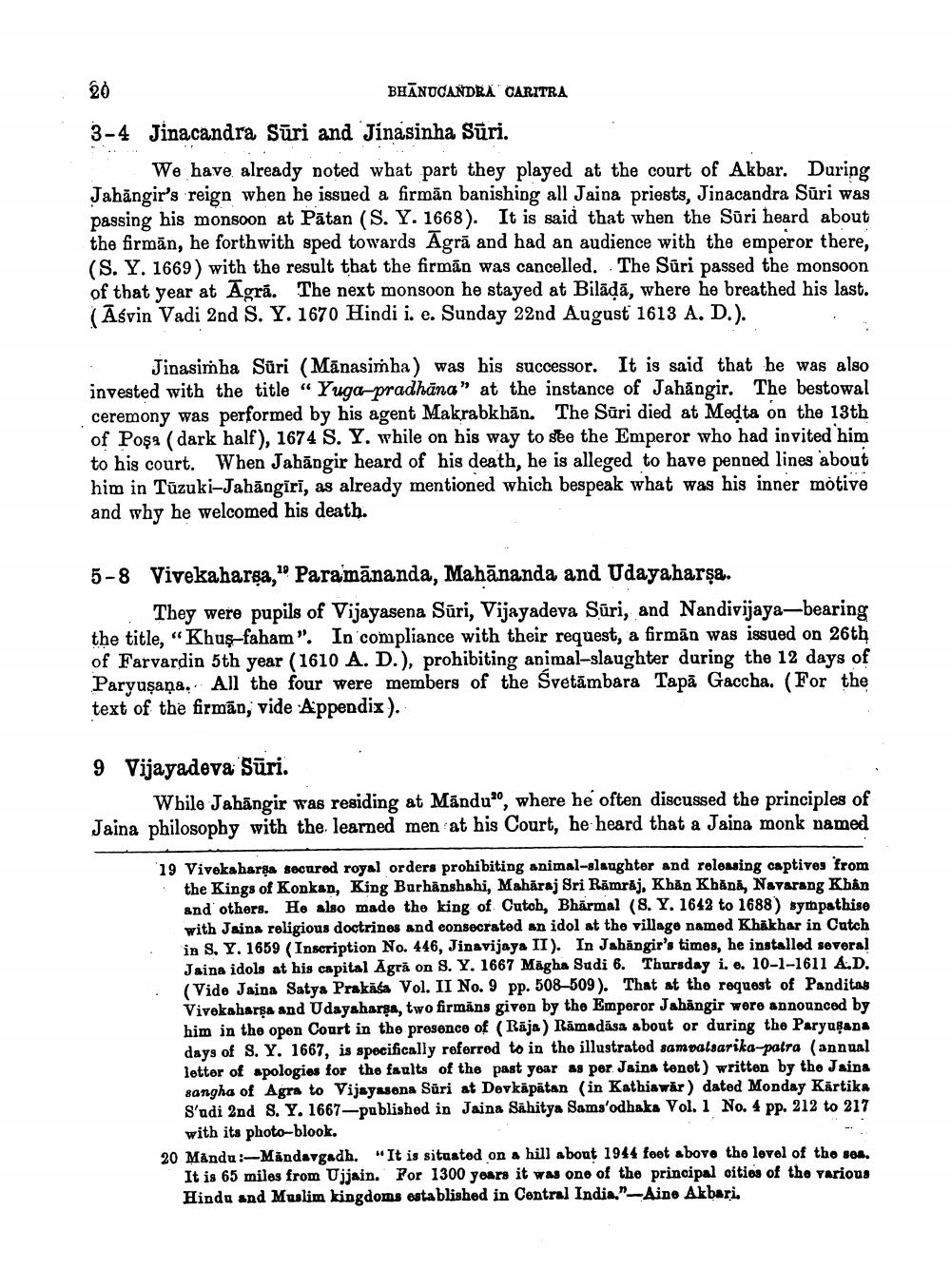________________
BHĀNUCANDRA CARITRA
3-4 Jinacandra Sūri and Jinasinha Sūri.
We have already noted what part they played at the court of Akbar. During Jahangir's reign when he issued a firmān banishing all Jaina priests, Jinacandra Sūri was passing his monsoon at Pātan (S. Y. 1668). It is said that when the Sūri heard about the firmān, he forthwith sped towards Agrā and had an audience with the emperor there, (S. Y. 1669) with the result that the firmān was cancelled. The Sūri passed the monsoon of that year at Agrā. The next monsoon he stayed at Bilādā, where he breathed his last. ( Āśvin Vadi 2nd S. Y. 1670 Hindi i. e. Sunday 22nd August 1613 A. D.).
. Jinasimha Sûri (Mānasimha) was his successor. It is said that he was also invested with the title “Yuga-pradhāna" at the instance of Jahangir. The bestowal ceremony was performed by his agent Makrabkhān. The Sūri died at Medta on the 13th of Poşa (dark half), 1674 S. Y. while on his way to see the Emperor who had invited him to his court. When Jahāngir heard of his death, he is alleged to have penned lines about him in Tüzuki-Jahāngirī, as already mentioned which bespeak what was his inner motive and why he welcomed his death.
5-8 Vivekaharşa,Paramānanda, Mahānanda and Udayaharşa.
They were pupils of Vijayasena Sūri, Vijayadeva Sūri, and Nandivijaya-bearing the title, “Khus-faham". In compliance with their request, a firmān was issued on 26th of Farvardin 5th year (1610 A. D.), prohibiting animal-slaughter during the 12 days of Paryusaņa. All the four were members of the Svetāmbara Tapā Gaccha. (For the text of the firmān, vide Appendix ).
9 Vijayadeva Sūri.
While Jahāngir was residing at Manduo, where he often discussed the principles of Jaina philosophy with the learned men at his Court, he heard that a Jaina monk named
19 Viveka harga secured royal orders prohibiting animal-slaughter and roleasing captives from
the Kings of Konkan, King Burhanshshi, Mahāraj Sri Ramraj, Khan Khāni, Navarang Khân and others. He also made the king of Cutsh, Bhärmal (8. Y. 1642 to 1688) sympathise with Jaina religious doctrines and consecrated an idol at tho village named Khakhar in Cutch in S, Y. 1659 (Inscription No. 446, Jinavijaya II). In Jahangir's times, he installed several Jsina idols at his capital Agrå on 8. Y. 1667 Mägha Sudi 6. Thursday i. e. 10-1-1611 A.D. (Vido Jaina Satya Prakasa Vol. II No. 9 pp. 508-509). That at the request of Panditas Vivekaharsa and Udayaharsa, two firmáns given by the Emperor Jahangir wore announced by him in the open Court in the presence of (Rāja ) Rāmadāsa about or during the Paryußans days of S. Y. 1667. is specifically referred to in the illustratod samvalsarika-patra (annual lettor of apologies for the faults of the past year as por Jaina tonet) written by the Jains sangha of Agra to Vijayasona Sūri at Devkāpātan (in Kathiawar ) dated Monday Kārtika S'udi 2nd 8. Y. 1667-published in Jaina Sahitya Sams'odhaka Vol. 1 No. 4 pp. 212 to 217
with its photo-blook. 20 Mandu:-Mändavgadh. "It is situated on a hill about 1944 foot above the lovel of the sea.
It is 65 miles from Ujjain. Por 1300 years it was one of the principal oities of the various Hindu and Muslim kingdoms established in Central India." -Aino Akbari.




